| Australian rules football in Ireland | |
|---|---|
 Ireland's Mike Finn takes a strong pack mark against South Africa in a 2008 International Cup match | |
| Country | Ireland |
| Governing body | AFL Ireland |
| National team(s) | Ireland |
| First played | 1999, Dublin & Belfast |
| Registered players | ~200 |
| Clubs | 9 |
Australian rules football in Ireland (Irish: Peil rialacha na hAstráile) began in 1999 when clubs were simultaneously formed in Dublin and Belfast, however awareness of Australian rules football dates back to the 20th century due to similarities with Gaelic football and the country subsequently became a source of players for professional leagues in Australia, particularly the Australian Football League (AFL) and later the AFL Women's (AFLW) through the Irish Experiment which is ongoing. It is governed by AFL Ireland which is a member of AFL Europe.
There are now two governing bodies, AFL Ireland and AFL Northern Ireland, with teams and competitions in Belfast, Cork, Dublin and Galway.
While coexisting with and relying heavily on players from Gaelic games, it has grown and Ireland has become one of the most decorated nations in Australian rules with the national team, formed in 2001, winning second most men's international titles (2) and most women's international titles (2) as well as the most European Championship titles (2) and Euro Cup women's titles (4). Professional AFL/AFLW players to have represented Ireland internationally include Laura Duryea, Clara Fitzpatrick and Padraig Lucey.
It attracts a television audience, particularly the AFLW competition (but also the men's AFL).[1] In 2023 there were a record 33 listed Irish The 33 Irish players set for the new AFLW season.[2] Jim Stynes (the first to win an AFL best and fairest) along with Tadgh Kennelly (first to win an AFL premiership), achieved a level of fame at home and in turn raised the profile of the AFL.[3][4][5] Ailish Considine was the first to win an AFLW premiership achieving similar fame.[6]
Current player Zach Tuohy holds the Irish born and raised record for the most most games while Jim Stynes holds the record for most goals with 130 while Cora Staunton holds the equivalent in the AFL Women's with the most games with 50 and most goals with 55.
History
One could argue that the Irish have been playing Australian rules as early as the 1870s, as recent evidence suggests that a form of football being played in south western Ireland at the time was played under Victorian rules in a fashion indistinguishable from that of the game played in Australia, and early on it was even played with a rugby ball, with a mark for catching the ball and with upright posts of the Australian game.[7] It is not known how or when the Victorian rules were introduced to Ireland, however its legacy can be found in the written rules of the Commercials Club of County Limerick from the early 1880s which later, along with elements of soccer, formed the basis for Gaelic Football.
Primarily Irish historians analysing accounts of the traditional Irish football caid and Gaelic Athletic Association (GAA) codified rules against the Melbourne Football Club rules of 1959 and Victorian Rules of 1866 and 1877 and those of other codes appear to strongly indicate that Gaelic football originated as a hybrid of Australian Football and Association Football. Like Australian Football, this was in an effort to differentiate from rugby[8] and was primarily based on the Victorian Rules of 1866 and 1877.[9] For example early codified Gaelic called for Australian rules style behind posts (not present in caid and later removed) with 5 point goals scoring (later changed to 3) and 1 point "behind"s all borrowed from Australian Rules, and Rule 27 in reference to kicking styles, Rule 15 relating to foul play and rules dictating playing equipment appear to be directly borrowed from the Victorian Rules. Early Victorian Rules was played with also a round ball until the introduction of the Sherrin in the 1880s. Other than the directly copied rules, analysts argue that so many of the rules are so similar to the Victorian Rules that the GAA must have obtained a deep knowledge of these laws. In any case the Irish game has been gradually evolving closer the Australian game since and as recently as 2017 with the GAA's introduced "the mark" from Australian Football, one of the game's other distinctive to encourage more spectacular aerial contests.[10]
Irish involvement in the early game in Australia
Irish have been involved in the game since its earliest days in Australia. Thomas H. Smith of Carrickmacross, County Monaghan[11] was involved in the formation of the Melbourne Football club from 1858 and the drafting of the first rules for the code in 1859.[12]
One of the founders of the St Kilda Football Club in 1873, J.J. Casey, was from Tromroe, County Clare.[13]
The Colony of Queensland's first club, the Brisbane Football Club in 1880s had a prominent Irish component, as such its early presidents Joshua Peter Bell and Kevin Izod O'Doherty were from Kildare and Dublin respectively.
Early interactions with Australian rules
In the 1920s, the GAA and Australasian Football Council were becoming increasingly aware of each other's growing global footprint and the first test matches between the two countries were proposed though were never contested with correspondence occurring between the two sporting bodies.[14]
First efforts to introduce the code into Ireland
The Australian High Commissioner to Ireland, Mr Mulrooney of the Canberra Australian Football Association attempted to introduce Australian Football to Dublin in 1946.[15]
The similarity between the codes eventually raised the awareness in Ireland of the Australian sport.[16] Certainly this awareness has grown substantially since the first International rules football tests took place in late 1967, however Aussie Rules was not officially played in Ireland until clubs were simultaneously formed in Dublin and Belfast in 1999.
Australian Football World Tour
In 1967, Harry Beitzel drew inspiration from watching the 1966 All-Ireland Senior Football Championship final on television and formed an Australian side, nicknamed "The Galahs", to play the game against an Irish side. The next year he organised the Australian Football World Tour, a six-match series with games played against Irish teams in Ireland, the United Kingdom and United States of America. What followed was the beginning of regular interaction between the two codes which was to become the hybrid code of International rules football played in both countries and facilitating the cross code competition.
Irish experiment
Ron Barassi, drawing comparisons between Australian rules football and Gaelic football was of the opinion that Gaelic footballers could provide a previously untapped pool of potential Australian Rules players.[17] As a result, wealthy Victorian clubs were scouting Ireland for new talent. In 1982, Barassi (then the Melbourne VFL club coach) and his recruiting team including Melbourne's Barry Richardson travelled to Ireland, looking for young, tall, and talented players.[18] Over the following years, a number of Irish athletes made the journey to Australia to play professionally in Australia. Players were found not only from Gaelic football codes, but other sports including hurling and rugby. Some, including Jim Stynes, Tadgh Kennelly and Martin Clarke, achieved a level of fame in Ireland either going on to careers in Australia or returning home to achieve success in their sports at home and along with the International Rules Series, increase the profile and awareness of the Australian game.[19][20][21]
Formation of the ARFLI and national team
Two clubs, in Dublin and Belfast, recruited and trained through the winter of 1999 and played a number of British Aussie rules clubs in challenge matches in early spring 2000. The Australian Rules Football League of Ireland (ARFLI) was formed in October 2000 after the first ever Irish Grand Final was contested between them. The following year, players from the clubs were drawn to form the first national team.
Growth and expansion
In the 2010s, the women's game grew rapidly and the first national team was established and players began to make their way to women's leagues in Australia.
By 2014, the league had grown to more than 200 players and expanded to six men's clubs and three women's clubs.
Competitions and Clubs
Competitions
| Competition | Founded | Notes |
|---|---|---|
| Australian Rules Football League of Ireland Premiership | 2001 | ARFLI website |
Clubs
| Club | Location | Founded | Notes |
|---|---|---|---|
| Belfast Redbacks | City of Belfast (Mallusk) Playing Fields, Mallusk, County Antrim, Belfast | 2010 | Belfast Redbacks website |
| Cork Vikings (womens) | Tramore Valley Park, Cork | 2020 | Cork Vikings website |
| Galway Magpies | South Park, Galway | 2010 | Galway Magpies website |
| Leeside Lions | Tramore Valley Park, Dublin | 2001 | Leeside Lions website |
| South Dublin Swans | Memorial Park, Kilmainham, Dublin | 2006 | South Dublin Swans |
| Ulster Kookaburras (womens) | Queen's University Malone Playing Fields, Belfast | 2021 | Ulster Kookaburras |
| Ulster Wolfhounds | Queen's University Malone Playing Fields, Belfast | 2021 |
National teams


Ireland's national team competes internationally at the Australian Football International Cup, AFL Europe Championship and Euro Cup.
History
An Irish National Aussie rules team, drawn from all ARFLI affiliated clubs headed to London between 6–15 October to take part in the Atlantic Alliance Cup 2001 – a five nations International competition with United States, Canada, Great Britain and Denmark providing the opposition. A final panel of 24 players, whittled down from 60 over a three-month training period made the trip. Ireland, playing their first ever competitive International matches, won all their games in the round robin series and went on to record a win against Denmark (pre-tournament favourites) in the Grand Final. This was a huge achievement for such a young league against teams from leagues that had been established for ten years plus. Darren Fitzpatrick of Kilkenny, who previously played Aussie Rules at a professional level with the Western Bulldogs in Australia, coached the team.
In August 2002, the National team attended the Australian Football International Cup (an Amateur World Cup for nations outside of Australia). The team went into the competition as third seeds behind Papua New Guinea and New Zealand. The competition was a success for Ireland as they beat Canada, Samoa, USA, South Africa and New Zealand in the group stage and went on to beat PNG in a televised final at the Melbourne Cricket Ground. The team which was again coached by Darren Fitzpatrick, and was captained by Michael Johnston.
In 2005, the "Green Machine" again attended the Australian Football International Cup. With injuries and late withdrawals, the team managed a fourth place behind New Zealand, Papua New Guinea and USA.
Jim Stynes' brother David coached the 2014 national side hoping to defend the title[22] however the side failed to defeat Papua New Guinea in the final.
The men's side was considered favourites going into the 2017 international cup,[23] thought they finished in 3rd place.
Governing body and participation
The governing body is AFL Ireland. Formerly it was the Australian Rules Football League of Ireland (ARFLI) until the league affiliated with the AFL Commission.
As of 2014, there were more than 200 senior players and in 6 men's clubs and 3 women's clubs.
Media coverage
The sport, and International Rules has been covered in the media for many years, though it was only in 2010 that there has been regular AFL coverage on television through TG4. The and also in the media, including the International Rules Series. In 2021 the AFLW began showing on TG4.[24]
Current issues
The sport in Ireland faces constant struggle, due to the massive popularity of the indigenous and similar sport of Gaelic football which discourages professionalism.
A controversial International Rules series in 2005 may have irreparably damaged the reputation of the code in Ireland, however the continued export of Gaelic football converts to Aussie Rules ensures that the sport continues to have a small following in Ireland.
Proximity to Great Britain and mainland Europe, where there are fairly strong Aussie Rules leagues gives teams from Ireland the opportunity to regularly participate in international competition and remain competitive through access to Gaelic football players.
Players
Australia has recruited several Irish Gaelic footballers to play Aussie Rules. As Gaelic football is primarily amateur competition and the AFL competition is professional, there is a strong financial lure.
Irish Players in the AFL
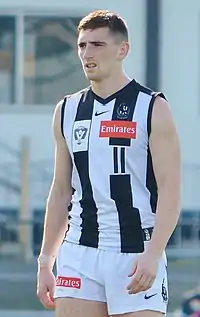 Mark Keane former gaelic footballer playing for Collingwood in 2021 is from Mitchelstown
Mark Keane former gaelic footballer playing for Collingwood in 2021 is from Mitchelstown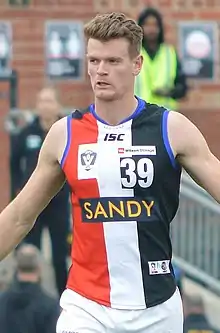 Darragh Joyce former hurler playing for St Kilda in 2021 is from Wexford
Darragh Joyce former hurler playing for St Kilda in 2021 is from Wexford Mark O'Connor former gaelic footballer playing for Geelong in 2019 is from Dingle
Mark O'Connor former gaelic footballer playing for Geelong in 2019 is from Dingle Conor Nash former Irish U18 national rugby footballer playing for Hawthorn in 2019 is from Navan
Conor Nash former Irish U18 national rugby footballer playing for Hawthorn in 2019 is from Navan Conor Glass former gaelic footballer playing for Hawthorn in 2018 is from Glen
Conor Glass former gaelic footballer playing for Hawthorn in 2018 is from Glen Conor McKenna former gaelic footballer playing for Essendon in 2018 is from Benburb
Conor McKenna former gaelic footballer playing for Essendon in 2018 is from Benburb Zach Tuohy former gaelic footballer playing for Geelong in 2018 is from Portlaoise
Zach Tuohy former gaelic footballer playing for Geelong in 2018 is from Portlaoise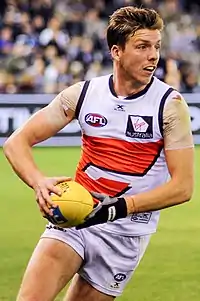 Aidan Corr playing for GWS in 2018 is from Brockagh
Aidan Corr playing for GWS in 2018 is from Brockagh Tommy Walsh gaelic footballer was recruited to St Kilda and the Sydney Swans
Tommy Walsh gaelic footballer was recruited to St Kilda and the Sydney Swans Joe Cunnane playing for Ireland in 2011
Joe Cunnane playing for Ireland in 2011 Mike Finn playing for Ireland in 2008
Mike Finn playing for Ireland in 2008 Statue of Jim Stynes who won the 1991 Brownlow Medal, and played 264 games for Melbourne, the most of any Irishman in VFL/AFL history.
Statue of Jim Stynes who won the 1991 Brownlow Medal, and played 264 games for Melbourne, the most of any Irishman in VFL/AFL history.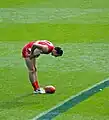 Tadhg Kennelly the first to be part of both an AFL premiership side and All-Ireland final winning team
Tadhg Kennelly the first to be part of both an AFL premiership side and All-Ireland final winning team Pearce Hanley former gaelic footballer playing for Brisbane
Pearce Hanley former gaelic footballer playing for Brisbane Setanta Ó hAilpín former hurler playing for Carlton
Setanta Ó hAilpín former hurler playing for Carlton Colm Begley former gaelic footballer playing for St Kilda
Colm Begley former gaelic footballer playing for St Kilda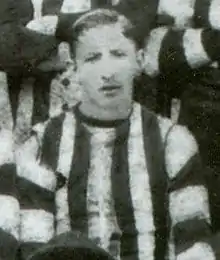 Denis Lanigan of Collingwood in 1895
Denis Lanigan of Collingwood in 1895
Irish Players in the AFLW
 Orla O'Dwyer playing for Brisbane in 2022
Orla O'Dwyer playing for Brisbane in 2022 Sinead Goldrick playing for Melbourne in 2021
Sinead Goldrick playing for Melbourne in 2021 Grace Kelly playing for West Coast in 2020
Grace Kelly playing for West Coast in 2020 Clara Fitzpatrick playing for St Kilda in 2019
Clara Fitzpatrick playing for St Kilda in 2019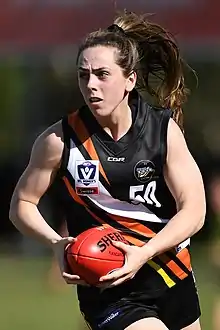 Aishling Sheridan playing for the Northern Territory in 2019
Aishling Sheridan playing for the Northern Territory in 2019 Aileen Gilroy playing for the Kangaroos in 2019
Aileen Gilroy playing for the Kangaroos in 2019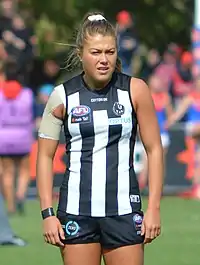 Sarah Rowe former Irish national Association footballer playing for Collingwood in 2019
Sarah Rowe former Irish national Association footballer playing for Collingwood in 2019 Cora Staunton playing for Greater Western Sydney in 2018
Cora Staunton playing for Greater Western Sydney in 2018 Ailish Considine playing for Adelaide in 2018
Ailish Considine playing for Adelaide in 2018 Laura Duryea playing for Melbourne in 2017
Laura Duryea playing for Melbourne in 2017
| Currently on an AFLW senior list |
| Player | Club/s | AFLW Years* | AFLW Matches* | AFLW Goals* | Connections to Ireland, References |
|---|---|---|---|---|---|
| Joanne Cregg | Fremantle | 2023- | - | - | Raised in County Roscommon |
| Orlagh Lally | Fremantle | 2023- | - | - | Raised in County Meath |
| Amy Mulholland | Fremantle | 2023- | - | - | Raised in County Armagh |
| Aine Tighe | Fremantle | 2023- | - | - | Raised in County Leitrim |
| Jennifer Dunne | Brisbane | 2023- | - | - | Raised in County Dublin |
| Cara McCrossan | Gold Coast Suns | 2023- | - | - | Raised in County Tyrone |
| Niamh McLaughlin | Gold Coast Suns | 2023- | - | - | Raised in County Donegal |
| Jennifer Higgins | Sydney | 2023- | - | - | Raised in County Roscommon |
| Tanya Kennedy | Sydney | 2023- | - | - | Raised in County Donegal |
| Paris McCarthy | Sydney | 2023- | - | - | Raised in County Kerry |
| Julie O'Sullivan | Sydney | 2023- | - | - | Raised in County Kerry |
| Dayna Finn | Carlton | 2023- | - | - | Raised in County Mayo |
| Erone Fitzpatrick | Carlton | 2023- | - | - | Raised in County Laois |
| Aishling Moloney | Geelong | 2023- | - | - | Raised in County Tipperary |
| Anna Rose Kennedy | Geelong | 2023- | - | - | Raised in County Tipperary |
| Aimee Mackin | Melbourne | 2023- | - | - | Raised in County Armagh |
| Niamh Martin | North Melbourne | 2023- | - | - | Raised in County Tipperary |
| Áine Tighe | Fremantle | 2022- | 21 | 14 | Raised in County Leitrim |
| Vicki Wall | North Melbourne | 2022- | 13 | 6 | Raised in County Meath |
| Blaithin Mackin | Hawthorn | 2022- | 10 | 2 | Raised in County Armagh |
| Aine McDonagh | Hawthorn | 2022- | 7 | 4 | Raised in County Galway |
| Erika O'Shea | North Melbourne | 2022- | 10 | - | Raised in County Cork |
| Bríd Stack | Greater Western Sydney | 2022- | 19 | 1 | Born and raised in Cork, County Cork |
| Orla O'Dwyer | Brisbane | 2020- | 42 | 12 | Raised in County Tipperary |
| Aileen Gilroy | North Melbourne, Hawthorn | 2020- | 38 | 3 | Born and raised in Killala, County Mayo |
| Aishling Sheridan | Collingwood | 2020- | 37 | 14 | Raised in County Cavan |
| Sinéad Goldrick | Melbourne | 2020- | 31 | - | Raised in County Cavan |
| Niamh Kelly | West Coast, Adelaide | 2020- | 30 | 6 | Raised in County Mayo |
| Grace Kelly | West Coast, St Kilda | 2020- | 23 | 9 | Raised in County Mayo |
| Rachel Kearns | Geelong | 2020- | 14 | 2 | Raised in County Mayo |
| Clara Fitzpatrick | St Kilda, Gold Coast Suns | 2020- | 12 | 0 | Raised in County Down |
| Joanne Doonan | Carlton, Essendon | 2020- | 11 | 1 | Raised in County Fermanagh |
| Niamh McEvoy | Melbourne | 2020-2021 | 8 | 1 | Raised in Malahide, County Dublin |
| Katy Herron | Western Bulldogs | 2020-2021 | 6 | 0 | Raised in County Donegal |
| Mairéad Seoighe | North Melbourne | 2020 | - | - | Raised in County Galway |
| Sarah Rowe | Collingwood | 2019- | 43 | 11 | Born and raised in Ballina, County Mayo[25] |
| Ailish Considine | Adelaide, North Melbourne | 2019- | 26 | 9 | Raised in County Clare |
| Yvonne Bonner | Greater Western Sydney | 2019- | 11 | 7 | Raised in County Donegal |
| Kate Flood | Fremantle | 2019-2020 | 7 | 5 | Raised in County Louth |
| Cora Staunton | Greater Western Sydney | 2018-2022 (S7) | 50 | 55 | Raised in Carnacon, County Mayo[26] |
| Laura Duryea | Melbourne | 2016-2018 | 11 | - | Raised in Drumlane, Belturbet and Milltown, County Cavan[27][28] |
See also
References
- ↑ The Cora effect: What's behind the explosion of Irish AFLW interest?by Gemma Bastiani 4 May 2023
- ↑ record number of imports from Ireland will feature with the oval ball this year by Maurice Brosnan for the Irish Examiner 31 August 2023
- ↑ The late great Jim Stynes made us imagine what is possible by Brian Fitzpatrick for IrishCentral. 29 March 2012
- ↑ JIM STYNES AND TADHG KENNELLY NAMED AMONG GREATEST IRISH AFL TEAM from Kildare Nationalist. 13 August 2021
- ↑ Marty Clarke given bigger role as AFL continue to eye gaelic footballers By Pat Nolan for the Irish Mirror. 21 March 2018
- ↑ Two-time Grand Final winner Ailish Considine on AFL uncertainty, her latest success and her future By Michael Scully for the Irish Mirror 5 May 2022
- ↑ Corrigan, Eoghan (2009). The History of Gaelic Football : the Definitive History of Gaelic Football from 1873. Dublin: Gill Books. ISBN 978-0-7171-6369-4. OCLC 1013828570.
- ↑ Did Aussie Rules Get There First? from Irish Daily Mail 25 October 2016
- ↑ Towards a Philosophy for Legislation in Gaelic Games Lennon, Joe. Dublin City University 1993. Pg 633, 638, 649, 658, 759
- ↑ Gaelic football introduces AFL-style mark By Vince Rugar
- ↑ pg 36. Melbourne FC, Since 1858 - An Illustrated History. Geoff Slattery Publishing 2008
- ↑ "ATHLETIC SPORTS". The Australasian. Vol. XX, no. 517. Victoria, Australia. 26 February 1876. p. 13. Retrieved 31 December 2017 – via National Library of Australia.
- ↑ "DEATH OF MR. J. J. CASEY". Bendigo Advertiser. Vol. LXI, no. 17, 989. Victoria, Australia. 7 April 1913. p. 5. Retrieved 14 August 2023 – via National Library of Australia.
- ↑ "AUSTRALIAN AND GAELIC CODES". The Australasian. Vol. CXXI, no. 4, 048. Victoria, Australia. 31 July 1926. p. 41 (METROPOLITAN EDITION). Retrieved 1 November 2021 – via National Library of Australia.
- ↑ "Our Football In Eire?". The Herald. No. 21, 708. Victoria, Australia. 16 December 1946. p. 6. Retrieved 21 June 2022 – via National Library of Australia.
- ↑ "AUSTRALIAN AND GAELIC CODES". The Australasian. Vol. CXXI, no. 4, 048. Victoria, Australia. 31 July 1926. p. 41 (METROPOLITAN EDITION). Retrieved 1 November 2021 – via National Library of Australia.
- ↑ "Barassi named No. 1". 15 March 2009. Archived from the original on 30 September 2012. Retrieved 22 August 2009.
- ↑ Tall, skinny kid with an Irish suntan by Martin Blake for The Age. March 21, 2012
- ↑ The late great Jim Stynes made us imagine what is possible by Brian Fitzpatrick for IrishCentral. 29 March 2012
- ↑ JIM STYNES AND TADHG KENNELLY NAMED AMONG GREATEST IRISH AFL TEAM from Kildare Nationalist. 13 August 2021
- ↑ Marty Clarke given bigger role as AFL continue to eye gaelic footballers By Pat Nolan for the Irish Mirror. 21 March 2018
- ↑ "David Stynes' Team out to defend AFL International Cup". independent.ie. 7 August 2014.
- ↑ "Meet Ireland's players in the Aussie Rules World Cup". irishtimes.com. 29 July 2017.
- ↑ "Irish women in Oz: TG4 to show women's Australian football". farmersjournal.ie. 27 January 2021.
- ↑ "Sport has added a new dimension to my life; one that doesn't focus on how I look". www.independent.ie. 1 August 2017. Retrieved 10 October 2019.
- ↑ Cora Staunton makes football history in Australia from Connaught Telegraph 10 Jan 2022
- ↑ "Cavan midfielder Laura Corrigan ready to make history in Aussie Rules". www.irishtimes.com. 22 January 2017. Retrieved 17 November 2019.
- ↑ "Fitness, food and 4-hour training sessions: A day in the life of Ireland's newest AFL star". www.the42.ie. 7 February 2017. Retrieved 18 November 2019.